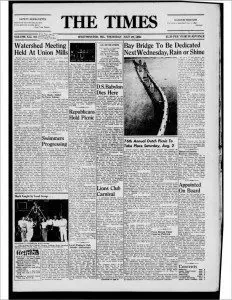Preserving History through Newspaper Digitization, Part Two

Last week, in the first part of our two-part blog mini-series, “Preserving History through Newspaper Digitization,” we outlined the importance of digitization to the preservation of our nation’s rich history. This week, we are going to take a closer look at newspaper digitization and, more specifically, the digitization of the Carroll County Times, a conversion service project completed by Crowley Imaging. Since its inception, Crowley Imaging has scanned between five and 10 million newspaper images with some of the originals dating back to the early 1800s.
Preserving History through Newspaper Digitization: The Carroll County Times
Founded in 1911, the Carroll County Times has been covering local Maryland news, as well as state, national and global issues ever since. Today, the Times is printed daily and also published online. Older issues of the popular newspaper, dating back to 1933, have been preserved in microfilm format by both the Enoch Pratt Free Library of Baltimore, Maryland and the Carroll County Public Library (CCPL).
When CCPL secured funding for the digitization of this historic publication, various options and vendors were considered. “We contacted several service bureaus and reviewed their processes, cost per image, informal reviews and locations,” explains CCPL information technology services manager, Bob Kuntz. Crowley Imaging was chosen for competitive pricing, capability to scan with full-text searchability and – a bonus – geographical proximity.
Crowley Imaging digitally scanned and indexed the microfilm records, which contained more than 13,000 issues of the Carroll County Times dating from 1933-2009. Digitization was performed on a Mekel Technology* MACH-series roll film scanner using QuantumScan and QuantumProcess software. These scanners are designed to digitize high volumes of microfilm and are sensitive to film that shows signs of wear and aging, making them an ideal fit for this project. The images were scanned to JPEG’s, which were then used to create multi-page searchable PDF files for each issue. Click here for a complete reading of the Carroll County Times case study.
Newspaper Digitization: Outsource or Purchase Equipment?
For most digitization projects, there are two options. One can purchase scanning equipment and complete the project in-house or outsource the project to a service bureau (scanning company) such as Crowley Imaging. How to decide?
According to company vice president, Pat Crowley, these are a few of several questions and considerations that will point to the best individual solution:
- How large is the digitization project? The equipment to provide a high-quality image may be cost prohibitive unless there is a large enough volume to justify the purchase. At Crowley Imaging, we typically use either a Zeutschel 12000 A1 overhead scanner for scanning from newspaper originals (bound or unbound) or a Mekel Technology microfilm or microfiche scanner to digitize newspapers that have previously been archived to a microform.
- What is the project timeline? A service bureau most likely has the capacity to manage the job in the shortest time frame possible.
- Does the infrastructure to manage all the processes in a typical conversion project (quality control, indexing, image processing, etc.) exist? Each step of the process from loading the reel, jacket or volume to final output must be considered. These are often more than meet the eye and require man-hours and infrastructure adaptations that may not be originally considered. One must factor in the costs of hiring an operator, training and the technical implementation of the final files into the existing IT system for the unit purchased.
- Consider the output files. Given the large format of a newspaper and the dynamic nature of a newspaper (sections, graphics, pictures, etc.), file format, file size and final destination (ie: online access) need to be serious considerations of the decision-making and budgeting process. Will the digitization be done in grayscale or color? Will access be given to page level or is article segmentation required? Answers to these and other questions introduce layers of complexity. Scanning/digitizing is very rarely a “press and play” operation.
Preserving History through Newspaper Digitization: Other Examples
The Carroll County Times is just one of the numerous significant newspaper digitization projects Crowley Imaging has completed. A very few other examples include the Towson University Towerlight, The Crusader of the College of the Holy Cross, several newspapers for the Somerset County Library System, such as the Crisfield Times, Somerset Herald, Marylander and Herald, and The Village Herald, and a wide variety of newspapers for SmallTownPapers.
If you have any questions about Preserving History through Newspaper Digitization, please contact The Crowley Company by calling (240) 215-0224. General inquiries can be emailed to [email protected]. You can also follow The Crowley Company on Facebook, Twitter, Google+, LinkedIn, Pinterest, and YouTube.
*Mekel Technology is owned by The Crowley Company and manufactures its high-end line of production microform scanners in San Dimas, California.

Very informative Blog 🙂
I’ve got some old newspapers, mostly from the early to mid 1800’s. I’ve also got a bunch of indentures. I do have a bound volume of The London Times from the 1860’s (about 2 or three months worth). I haven’t a clue what a machine capable of handling that would cost, but since you don’t advertise that, I’m asking!
Don
Don – thanks for taking the time to comment. If you don’t mind completing this form, we can have a territory rep contact you with more information. There are several scanners that fit these requirements, but there are a lot of variables to determine the correct scanner for your use, so more information is required to give you the best answer. https://thecrowleycompany.com/get-a-quote/film-and-scanning-equipment/